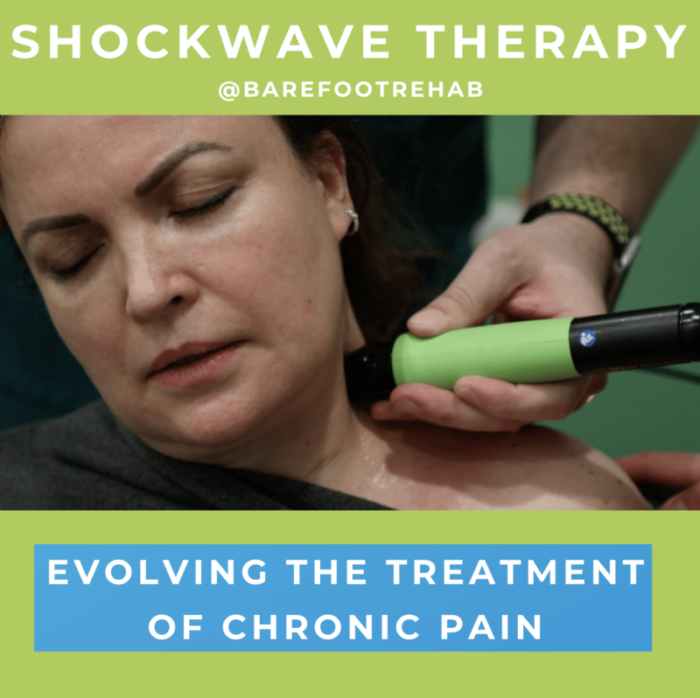
05 Jan Shockwave Therapy: Evolving the Treatment of Chronic Pain
Interested in shockwave therapy for your chronic pain?
Good, you should be.
We started using Shockwave Therapy in October, 2021, and the results have been a significant upgrade in the already awesome permanent relief results we get our patients.
You can observe a 14 min actual patient treatment video here. It’s posted near the bottom of this post, but if you’re feeling giddy, just click the link!
As of this post, we have:
- 66 reviews on Facebook (4.9 grade out of 5)
- 90 reviews on Google (4.8 grade out of 5)
- 80 Youtube Success Stories
Before we discuss treatment, we have to discuss the problem.
Shockwave therapy is amazing, but only for the right problems and the right patients.
Just because you have a golden hammer doesn’t mean that you can use it on screws and nuts.
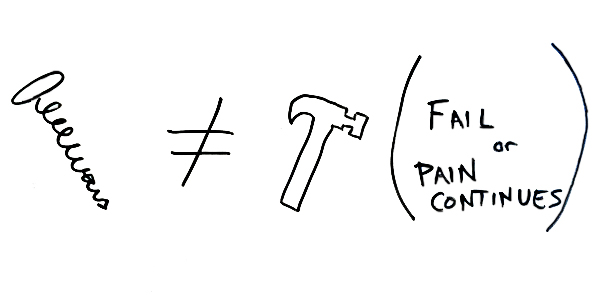
Hammers only work on nails.
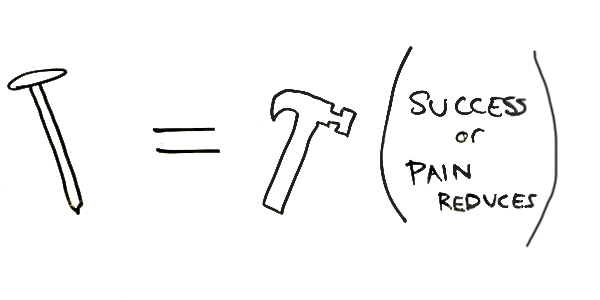
PROBLEM: #1 Cause of Chronic Pain for 30-50 Year Olds
Barefoot Rehab is clinic in Denville, NJ (45 mins outside of New York City) that specializes in PERMANENT pain relief for people who have had pain:
- over 6 months
- seen 3+ doctors or therapists WITHOUT relief
We do this without surgery, injections, or medications.
How?
We are the ONLY Clinic in New Jersey certified to find and fix the most common cause of chronic pain that 9 out of 10 of our patients have never heard of.
It’s kinda like GLUE in your muscles called ADHESION.
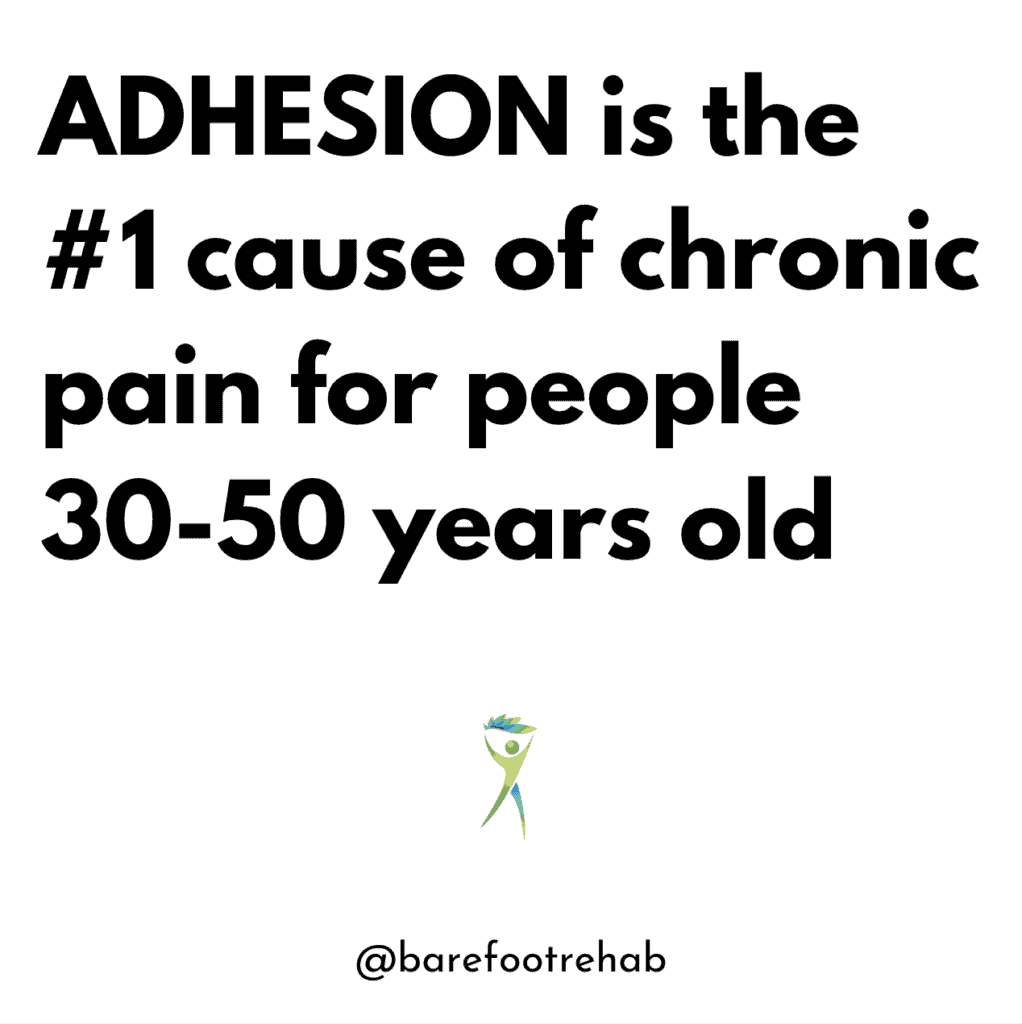
Because adhesion is:
- all over most individuals and most of their body parts
- is hardly addressed by pain doctors
- requires a ridiculous amount of training to get good at it (which we’ve done and continue to do)
… we focus 90% of our treatment plans on THIS NAIL — adhesion.
You may have noticed the “30-50 years old” line above.
People older than 50 have tons of adhesion too.
The problem is, they have also lived enough life with their adhesion that they have significant levels of arthritis (aka “wear and tear” aka “joint degeneration”), which lowers the percentage of permanent relief we can promise.
Adhesion is Barefoot Rehab’s Bread and Butter.
This is the problem we fix.
2010 – 2021: How We Fixed Adhesion
For 11 years of practice, we removed this fascial glue called ADHESION with 2 primary methods.
- Our hands (MAR, or Manual Adhesion Release)
- A metal instrument that looks like a credit card (Instrument Adhesion Release)
These are methods taught by Dr. William Brady of Integrative Diagnosis, who saved me from quitting chiropractic school half-way through when I realized adjustments weren’t helping my mild, chronic aches at 23 years old (5 min video below)
Dr. Brady’s Integrative Diagnosis is a complete system for the diagnosis and conservative care for musculoskeletal pains.
He preaches:
Before you ever touch a patient, you have to know:
- What tissue(s) is a problem?
- What pathology(s) does it have?
- What’s the gold standard treatment for that problem?
When we share this diagnostic framework to our patients, they look at us with a face that says, “Uhh, duh.”
Then, we ask them how many diagnoses they’ve had seeing the last 3, 10, or 30 doctors they’ve seen?
Like Diana who saw 30 specialists before finding us …
If we want to “twist the knife” so they really understand how important it is to have a correct and complete diagnosis, we ask them:
Even if you had the right diagnosis, you’re still in pain right?
So was the diagnosis wrong?
Or did they not have the right treatment for the correct diagnosis?
Then, the chronic pain sufferer can answer these questions themselves. Cuz they’re still hurting despite trying and flushing money down the toilet.
For the Tissue Problem – ADHESION – that can occur anywhere fascia lives, but primarily in and around muscles, ligaments, tendons, and bones, the best way to treat it has been:
- Our hands
- A metal instrument (only sold to Integrative Diagnosis doctors, so it’s not available for consumers to purchase on their own)
When would should any pain doctor use one treatment vs. another?
It’s always vital that the correct treatment protocol be used on each tissue.
When should any pain doctor us one treatment vs. another?
The general answer is:
Whatever removes the adhesion most efficiently.
We get a lot of DMs on our IG Profile asking us about the treatments they’re getting since they can’t make it to New Jersey.
Foot pain is a common one.
Frustrated foot pain sufferers will often say, “I’m getting Graston on my calf and massage on the bottom of my feet.”
We answer:
I appreciate your pain doctor/therapist trying the best they can, but those treatments won’t work there.
You need hands on treatment for the deep calf muscles.
You need an instrument to treat the bottom of the foot.
This is a generalization – but I use it to convey a point.
- Treatment must increase Range of Motion (what we call “Function”)
- Only when Function Improves will symptoms go away permanently
Check out this 2 minute video of BEFORE & AFTER tests of one of our patients with Frozen Shoulder.
Even if you’re getting temporary relief, but your range of motion hasn’t permanently improved, your symptoms are virtually guaranteed to return.
Remember …
The goal of treatment is results in the form of permanent relief, nothing else.
These two treatments took us to where we were in October, 2021, until Dr. Brady introduced Shockwave Therapy to Integrative Diagnosis doctors.
Why Shockwave Therapy is Revolutionary for Chronic Pain
Extracorporeal shockwave therapy (ESWT), or what I’ll continue to call “Shockwave Therapy”, was being used for musculoskeletal problems back in around 2002.
NOTE: Any numbered links to resources in this document comes from the following comprehensive review paper:
- Extracorporeal shockwave therapy in musculoskeletal disorders Journal of Orthopaedic Surgery and Research volume 7, Article number: 11 (2012)
Historically, this technology has been used to break up kidney stones.
The current research on pubmed.gov shows therapeutic benefits for:
- plantar fasciitis – success rates ranging from 34–88% [1, 45–62]
- lateral epicondylitis (tennis elbow) – success rates ranging from 68 – 91% [69–75]
- calcific or non-calcific tendonitis of the shoulder – success rates ranging from 78% to 91% [84–93]
- patellar tendinopathy (jumper’s knee) – success rates ranging from 73.5% to 87.5% [16, 19, 43, 98–100]
- avascular necrosis of the femoral head [21, 22, 113–116]
- achilles tendinopathy
- complex regional pain syndrome (RSD or reflex sympathetic dystrophy) [120]
- osteoarthritis of the knee [121]
- trapezius pain (Source)
NOTE: The paper cited above has a few studies that show no therapeutic benefit with shockwave therapy. The authors and our doctors share the same opinion – that lack of results may be due to:
- correct patient selection
- machine selection
- treatment protocol
- principles used
Our generalized conclusion is that shockwave therapy appears better than doing nothing, corticosteroids, and physical therapy alone.
Remember, chronic pain is complex. Every person is unique. At Barefoot Rehab, we tailor our treatment to every single patient – I can’t think of a patient who didn’t get both strengthening exercises in addition to adhesion release.
Choosing just one tool (a hammer) can’t build a house.
Choosing one treatment can’t fix chronic pain all the way.
This is one of the cons of scientific research.
Fixing chronic pain is an art.
Sometimes our patients look at me like I’m a chicken with my head cut off when I say:
“You need to do 30 days of Paleo then we’ll schedule our first treatment.”
OR
“I need you to meditate 15 minutes a day so you calm down your incessant fight-or-flight state.”
We do what it takes to address each piece of someone’s chronic pain diagnosis.
Here’s how shockwave therapy works wonders for the adhesion piece …
How does shockwave therapy work?
Our hands or a metal instrument treatment works by mechanically tearing the adhesion apart.
Imagine a 3 year old pulling a rubber band apart.
That’s the type of force that has historically been needed (and why myofascial release doesn’t work – letting the tissue slide isn’t applying tension) 2 min video below
Shockwave therapy doesn’t work through applied tension.
It’s a similar technology to ultrasound.
While ultrasound is biphasic (pulsed) and has a peak pressure bar of 0.5, shockwave therapy is uniphasic (constant) and has a peak pressure bar of 500.
That makes shockwave therapy 1000x as strong as ultrasound.
Shockwave utilizes high energy acoustic waves and an electric current to produce a strong magnetic field that have several effects on the treated tissue:
- Autophagy – it eats “old” or senescent cells in the body
- Releases stem cells – which is particular helpful for degenerated cartilage/joints (more on that later)
- Promotes new blood vessel growth – while muscles are red (have lots of blood flow), ligaments and tendons are white (and don’t have good blood flow. Less blood flow means less healing. Anything we can do to restore blood flow is helpful to achieving permanent relief.
- Breaks up adhesion – we can actually feel it melt under our fingers while treating it (see the video later)
Three months in, and so far, our patients and doctors are loving this new technology.
Who shouldn’t use shockwave therapy?
This treatment is extremely safe.
But here’s who 100% shouldn’t use it:
- pregnant women
- active tumor diseases
- corticosteroid or anabolic steroid use within 6 weeks
The treating doctor/therapist can treat, but must be cautious for those with:
- coagulation disorders (hemophilia)
- anticoagulant use (especially warfarin)
- thrombosis
- near a heart pacemaker
2021 & Beyond: How Barefoot Rehab Is Innovating With Shockwave Therapy
We’ve found we’re using shockwave therapy 60% of the time on patients.
That leaves 40% of treatment for our hands or our metal instrument.
It’s being used more than our more classical treatments because it’s getting better range of motion/function improvements than our hands or the metal instrument.
We’re able to treat a greater surface area of glued up tissue with shockwave.
Some of this is due to the practical nature of using our hands.
It’s tiring for our doctors.
As a fairly fit 37 year old who played college football, there’s only so much treatment my severely arthritic hands can handle.
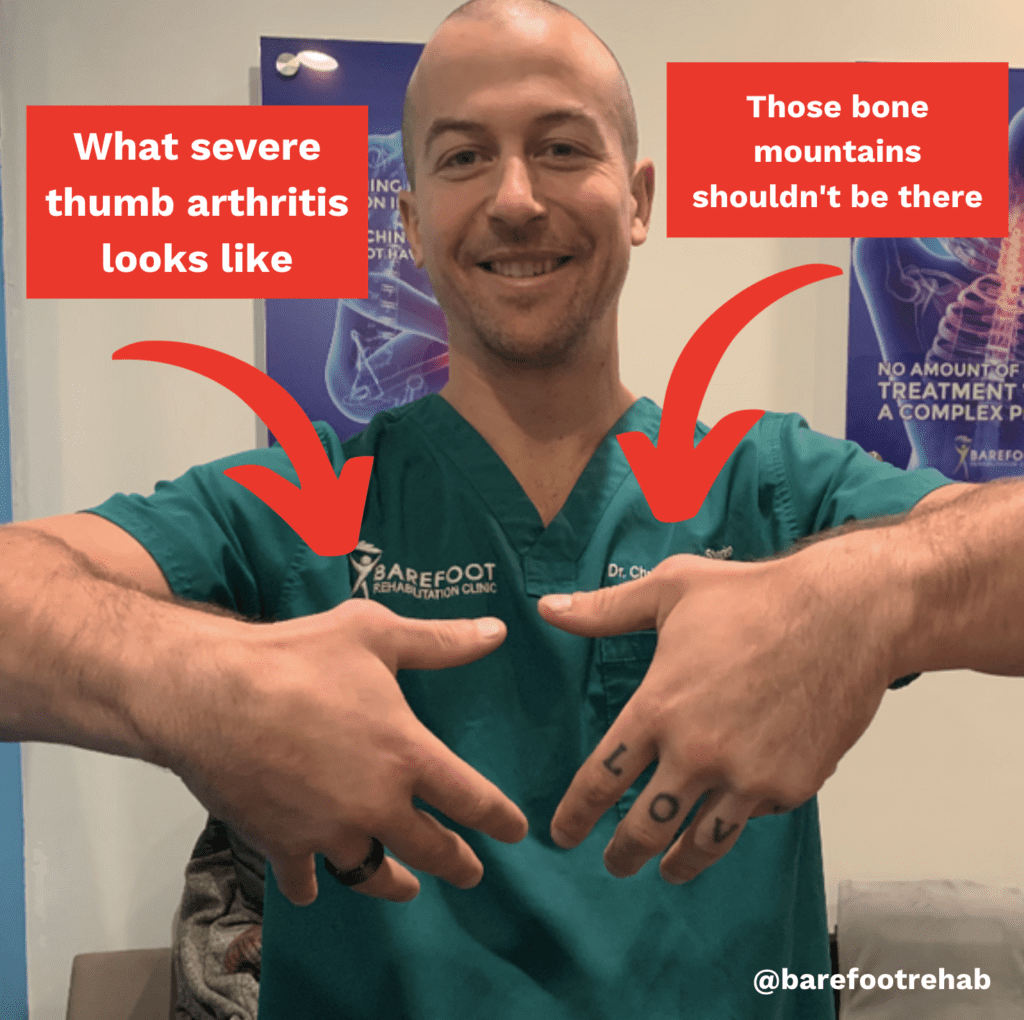
We’ve even had a doctor quit working at Barefoot Rehab because performing the treatment was too hard on his body.
Also, we can only do as much treatment that a patient can handle.
It ends up being around 5 minutes of treatment no matter which tool we choose.
Shockwave therapy has the added benefits of promoting new blood vessel growth, releasing stem cells, and eating “aged” or senescent cells.
This is why we’re getting better range of motion and permanent pain relief jumps than before, like we did for Kate’s chronic shoulder pain below (14 min video):
We utilize Shockwave Therapy with the same principles as taught by Dr. Brady.
- Find the adhesion
- Bring the adhesion to end range, which makes it more vulnerable to be broken
- When the end range gives because the adhesion has been broken, our clinical assistants move the body part into further range, making the next adhesion vulnerable to be broken.
- The doctor feels the adhesion under the Shockwave therapy head to make sure it’s melting before moving to the next one.
Following these principles, we’ve found that we can treat even more body regions than the research has shown.
The rule is, if we feel the adhesion go away, the treatment worked!
If we didn’t feel the adhesion go away, we get in there and use our hands or the instrument.
We Can Now Treat Degenerated Joints!
In the past, we’d tell people that we can only slow down how fast a degenerated joint progresses. We couldn’t make cartilage that is worn-and-torn grow back.
That means, we couldn’t do anything about a herniated disc, a torn meniscus, or a degenerated labrum.
Now, with shockwave therapy, we’re able to regenerate cartilage!
You’ve already heard of stem cell therapy – shockwave therapy is doing the same – as long as we can reach it.
So far, we’ve had success treating:
- herniated discs in the low back
- degenerated labrums in the shoulder or hip
- torn menisci in the knees
This is a huge upgrade in the number of cases that we can get an extra 20-40% relief for!
Lifestyle Changes to Optimize How Much Permanent Relief You Get!
All pain is load (water in our bucket) exceeding our capacity (size of our bucket).
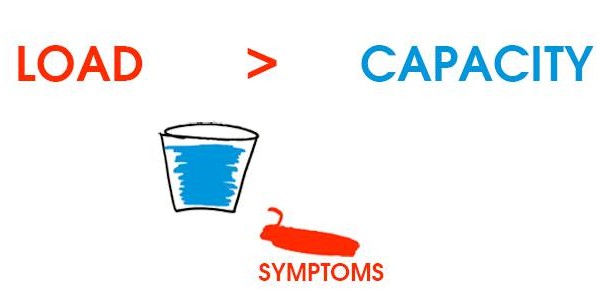
Because shockwave therapy is a higher dosage of treatment than our hands or the instrument, we tell our patients to reduce load on the body by 50%.
That means they have to cut back their workouts, minimize sitting, or reduce stress to the area by at least half.
In the last three months, we’ve inflamed more than our normal number of patients with this treatment.
That doesn’t make it bad – it just means people have to adjust and they may need more time to recover.
It’s also imperative that our patients eat Chris Kresser’s version of a “Paleo Diet”. His book, The Paleo Cure (Affiliate | Non-Affiliate), is our reference guide.
Simply, this is an ancestral way of eating that maximizes healing foods and minimizes toxic foods. In short, you’ll heal faster.
Sleeping 7-8 hours a night will ensure healing.
Conclusion – Sick & Tired of “Trying” Options?
Sometimes people call our office and say, “I can’t wait to be out of pain!”
While we love their optimism, some patients are too far gone or won’t do what it takes to get out of pain.
We DO NOT fix every patient who walks through our doors.
However, we currently have 3 doctors treating patients and the success we’ve had in the clinic is because we’ve been able to help patients who have already been failed by at least 3 other doctors or therapists.
With Shockwave therapy, we now have a cutting edge tool to get you better permanent pain relief results than ever before.
As always, the first step to seeing if you’re even a candidate for our care is to call our office, 862-205-4847, and ask our Officers of Delight at the front desk to schedule a free 30 minute phone call with one of our patient advocates.
If they give you the green light, they’ll set up a consult with the appropriate body region doctor in person (if you live in New Jersey) or virtual (if you live outside New Jersey) to get a diagnostic hypothesis of what’s wrong.

No Comments